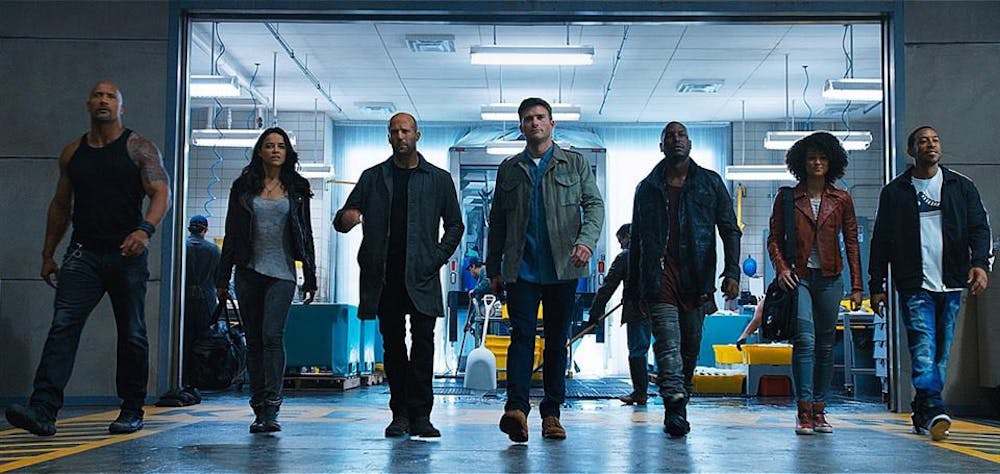Since its modest beginnings as a low-budgeted “Point Break” ripoff, the “Fast and Furious” franchise has evolved — amping up the spectacle so many times that the latest entries do not remotely function on the same scale as their predecessors. The characters who started as working-class outlaws are now combating global annihilation — Dominic “Dom” Toretto (Vin Diesel) and company are less likely to street race in the sweaty, grimy streets of Los Angeles than they are expected to disarm nukes and torpedo-launching submarines. It’s been a long road.
The series’ latest installment, “The Fate of the Furious,” continues the tradition of the franchise outdoing itself with gigantic set pieces, a massive CGI budget and a dark tonal shift in its premise. Dom betrays his squad after being blackmailed by Cipher (Charlize Theron) into stealing an EMP device to unleash massive global anarchy. It’s up to Dom’s “family” — the ever-expanding crew comprising of Hobbs (Dwayne Johnson), Letty (Michelle Rodriguez), Roman (Tyrese Gibson) and Tej (Chris ‘Ludacris’ Bridges) — to thwart Cipher’s nihilist plan and return Dom to normalcy.
The one element consistent across all the “Fast and Furious” films is an emphasis on family, which ranges from a stock justification for the films’ most absurd plot developments to a genuine, selfless sense of camaraderie between the characters. Dom “going rogue” at the expense of his previously uncompromised family values is a compelling premise, and his apparent betrayal is initially presented as a legitimate source of tension and dread. The Toretto bunch, unfortunately, hardly lingers on Dom’s disloyalty — they spend little time speculating his motivations for joining Cipher and instead immediately work to overthrow the new duo. The conflict devolves from legitimate character-driven drama to a handful of close-ups of an incredulous Letty and contrived expository dialogue about the impediment of confronting the scale of Cipher’s technical prowess.
“The Fate of the Furious” abandons its fundamental familial values. Deckard Shaw (Jason Statham) is responsible for the film’s best moments — his hard-boiled presence provides an engaging and necessary counterpoint to the earnest optimism of the Toretto crew. Yet, the villain has a history of generating ineffable damage to Dom’s family, even killing beloved member Han. He should be as far away from the gang as possible, but in “The Fate of the Furious,” he becomes a valued member all too quickly.
While Hobbs initially resists collaborating with Deckard, the two become friends after a brief scene where they heartily laugh together and help each other move some tools. The graceful ease with which the team accepts Deckard not only misrepresents the heartfelt string which tied the films together, but also acts as a disingenuous admission that the film’s sentiments are about as real as the its stunts.
“The Fate of the Furious” is a series of missed opportunities, most evidently clear in Cipher’s character. The film deprives her of any memorable action sequence — instead confining her to a hacking room where she espouses trite punchlines like “Get ready for this” and “Hack them all” before pushing a button that initiates some grandiose, CGI-infused mass destruction. How do you bring Imperator Furiosa into your movie and not put her behind the wheel?
The franchise has consistently suffered from lackluster villains, but Cipher stands out as the most unforgivable — not only in terms of wasted potential, but also in poor execution. The jarring, self-important tone of Cipher’s scenes contrasts sharply with the ridiculous, buddy comedic antics of Dom and his family. The result is a sprawling film more disjointed than the dozen plus pileup of cars seen after Cipher forces them to plummet from high-rising buildings to the New York City streets.
With all this said, “The Fate of the Furious” still provides a nominal amount of fun. In the film’s first 10 minutes, Dom navigates through the streets of Havana and is complimented by a vibrant color palette, pumping soundtrack, enthusiastic extras and classic cars. Out of honor and defense for his cousin, Dom races a local who tries to win his cousin’s junker — paying homage to the earlier films while illustrating Dom’s wholesome adherence to family values. The sequence has enough boundless energy to overcome its inherent silliness.
However, this escapism does not nearly extend through the arduous 136 minute duration of “The Fate of the Furious.” The franchise seems to be wrestling with its newfound identity — abandoning the long-established, charming focus on family and replacing it with nothing particularly groundbreaking or interesting.







